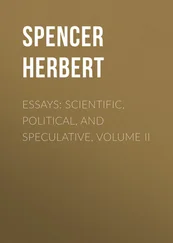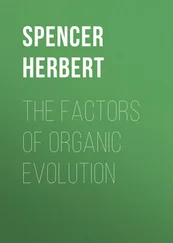It may not be amiss here to ask—What is the meaning of these integrations? The evidence seems to show that they are in some way dependent on community of function. The eight segments which coalesce to make the head of a centipede, jointly protect the cephalic ganglion, and afford a solid fulcrum for the jaws, &c. The many bones which unite to form a vertebral skull have like uses. In the consolidation of the several pieces which constitute a mammalian pelvis, and in the anchylosis of from ten to nineteen vertebræ in the sacrum of a bird, we have kindred instances of the integration of parts which transfer the weight of the body to the legs. The more or less extensive fusion of the tibia with the fibula and the radius with the ulna in the ungulated mammals, whose habits require only partial rotations of the limbs, is a fact of like meaning. And all the instances lately given—the concentration of ganglia, the replacement of many pulsating blood-sacs by fewer and finally by one, the fusion of two uteri into a single uterus—have the same implication. Whether, as in some cases, the integration is merely a consequence of the growth which eventually brings into contact adjacent parts performing similar duties; or whether, as in other cases, there is an actual approximation of these parts before their union; or whether, as in yet other cases, the integration is of that indirect kind which arises when, out of a number of like organs, one, or a group, discharges an ever-increasing share of the common function, and so grows while the rest dwindle and disappear;—the general fact remains the same, that there is a tendency to the unification of parts having similar duties.
The tendency, however, acts under limiting conditions; and recognition of them will explain some apparent exceptions. In the human fœtus, as in the lower vertebrata, the eyes are placed one on each side of the head. During evolution they become relatively nearer, and at birth are in front; though they are still, in the European infant as in the adult Mongol, proportionately further apart than they afterwards become. But this approximation shows no signs of further increase. Two reasons suggest themselves. One is that the two eyes have not quite the same function, since they are directed to slightly-different aspects of each object looked at; and, since the resulting binocular vision has an advantage over monocular vision, there results a check upon further approach towards identity of function and unity of structure. The other reason is that the interposed structures do not admit of any nearer approach. For the orbits of the eyes to be brought closer together, would imply a decrease in the olfactory chambers; and as these are probably not larger than is demanded by their present functional activity, no decrease can take place. Again, if we trace up the external organs of smell through fishes, [7]reptiles, ungulate mammals and unguiculate mammals, to man, we perceive a general tendency to coalescence in the median line; and on comparing the savage with the civilized, or the infant with the adult, we see this approach of the nostrils carried furthest in the most perfect of the species. But since the septum which divides them has the function both of an evaporating surface for the lachrymal secretion, and of a ramifying surface for a nerve ancillary to that of smell, it does not disappear entirely: the integration remains incomplete. These and other like instances do not however militate against the hypothesis. They merely show that the tendency is sometimes antagonized by other tendencies. Bearing in mind which qualification, we may say, that as differentiation of parts is connected with difference of function, so there appears to be a connexion between integration of parts and sameness of function.
Closely related to the general truth that the evolution of all organisms is carried on by combined differentiations and integrations, is another general truth, which physiologists appear not to have recognized. When we look at the organic world as a whole, we may observe that, on passing from lower to higher forms, we pass to forms which are not only characterized by a greater differentiation of parts, but are at the same time more completely differentiated from the surrounding medium. This truth may be contemplated under various aspects.
In the first place it is illustrated in structure . The advance from the homogeneous to the heterogeneous itself involves an increasing distinction from the inorganic world. In the lowest Protozoa , as some of the Rhizopods, we have a homogeneity approaching to that of air, water, or earth; and the ascent to organisms of greater and greater complexity of structure, is an ascent to organisms which are in that respect more strongly contrasted with the relatively structureless masses in the environment.
In form again we see the same truth. A general characteristic of inorganic matter is its indefiniteness of form, and this is also a characteristic of the lower organisms, as compared with the higher. Speaking generally, plants are less definite than animals, both in shape and size—admit of greater modifications from variations of position and nutrition. Among animals, the Amœba and its allies are not only almost structureless, but are amorphous; and the irregular form is constantly changing. Of the organisms resulting from the aggregation of amœba-like creatures, we find that while some assume a certain definiteness of form, in their compound shells at least, others, as the Sponges, are irregular. In the Zoophytes and in the Polyzoa , we see compound organisms, most of which have modes of growth not more determinate than those of plants. But among the higher animals, we find not only that the mature shape of each species is quite definite, but that the individuals of each species differ very little in size.
A parallel increase of contrast is seen in chemical composition . With but few exceptions, and those only partial ones, the lowest animal and vegetal forms are inhabitants of the water; and water is almost their sole constituent. Dessicated Protophyta and Protozoa shrink into mere dust; and among the acalephes we find but a few grains of solid matter to a pound of water. The higher aquatic plants, in common with the higher aquatic animals, possessing as they do much greater tenacity of substance, also contain a greater proportion of the organic elements; and so are chemically more unlike their medium. And when we pass to the superior classes of organisms—land plants and land animals—we find that, chemically considered, they have little in common either with the earth on which they stand or the air which surrounds them.
In specific gravity , too, we may note the like. The very simplest forms, in common with the spores and gemmules of the higher ones, are as nearly as may be of the same specific gravity as the water in which they float; and though it cannot be said that among aquatic creatures superior specific gravity is a standard of general superiority, yet we may fairly say that the superior orders of them, when divested of the appliances by which their specific gravity is regulated, differ more from water in their relative weights than do the lower. In terrestrial organisms, the contrast becomes extremely marked. Trees and plants, in common with insects, reptiles, mammals, birds, are all of a specific gravity considerably less than the earth and immensely greater than the air.
We see the law similarly fulfilled in respect of temperature . Plants generate but an extremely small quantity of heat, which is to be detected only by delicate experiments; and practically they may be considered as being in this respect like their environment. Aquatic animals rise very little above the surrounding water in temperature: that of the invertebrata being mostly less than a degree above it, and that of fishes not exceeding it by more than two or three degrees, save in the case of some large red-blooded fishes, as the tunny, which exceed it by nearly ten degrees. Among insects, the range is from two to ten degrees above that of the air: the excess varying according to their activity. The heat of reptiles is from four to fifteen degrees more than that of their medium. While mammals and birds maintain a heat which continues almost unaffected by external variations, and is often greater than that of the air by seventy, eighty, ninety, and even a hundred degrees.
Читать дальше












